2015 NISSAN GT-R warning
[x] Cancel search: warningPage 30 of 358
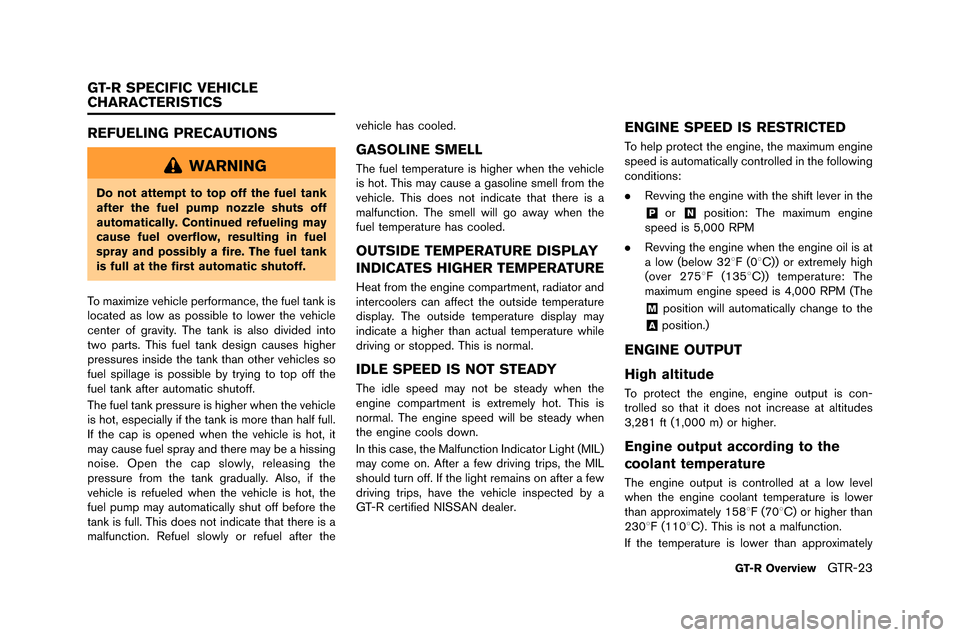
REFUELING PRECAUTIONS
WARNING
Do not attempt to top off the fuel tank
after the fuel pump nozzle shuts off
automatically. Continued refueling may
cause fuel overflow, resulting in fuel
spray and possibly a fire. The fuel tank
is full at the first automatic shutoff.
To maximize vehicle performance, the fuel tan�f is
located as low as possi�ble to lower the vehicle
center of gravity. The tan�f is also divided into
two parts. This fuel tan�f design causes higher
pressures inside the tan�f than other vehicles so
fuel spillage is possi�ble �by trying to top off the
fuel tan�f after automatic shutoff.
The fuel tan�f pressure is higher when the vehicle
is hot, especially if the tan�f is more than half full.
If the cap is opened when the vehicle is hot, it
may cause fuel spray and there may �be a hissing
noise. Open the cap slowly, releasing the
pressure from the tan�f gradually. Also, if the
vehicle is refueled when the vehicle is hot, the
fuel pump may automatically shut off �before the
tan�f is full. This does not indicate that there is a
malfunction. Refuel slowly or refuel after the vehicle has cooled.
GASOLINE SMELL
The fuel temperature is higher when the vehicle
is hot. This may cause a gasoline smell from the
vehicle. This does not indicate that there is a
malfunction. The smell will go away when the
fuel temperature has cooled.
OUTSIDE TEMPERATURE DISPLAY
INDICATES HIGHER TEMPERATURE
Heat from the engine compartment, radiator and
intercoolers can affect the outside temperature
display. The outside temperature display may
indicate a higher than actual temperature while
driving or stopped. This is normal.
IDLE SPEED IS NOT STEADY
The idle speed may not �be steady when the
engine compartment is extremely hot. This is
normal. The engine speed will �be steady when
the engine cools down.
In this case, the Malfunction Indicator Light (MIL)
may come on. After a few driving trips, the MIL
should turn off. If the light remains on after a few
driving trips, have the vehicle inspected �by a
GT-R certified NISSAN dealer.
ENGINE SPEED IS RESTRICTED
To help protect the engine, the maximum engine
speed is automatically controlled in the following
conditions:
.
Revving the engine with the shift lever in the
&Por&Nposition: The maximum engine
speed is 5,000 RPM
. Revving the engine when the engine oil is at
a low (�below 328F (08C)) or extremely high
(over 2758 F (1358C)) temperature: The
maximum engine speed is 4,000 RPM (The
&Mposition will automatically change to the
&Aposition.)
ENGINE OUTPUT
High altitude
To protect the engine, engine output is con-
trolled so that it does not increase at altitudes
3,281 ft (1,000 m) or higher.
Engine output according to the
coolant temperature
The engine output is controlled at a low level
when the engine coolant temperature is lower
than approximately 1588F (708C) or higher than
2308F (1108C). This is not a malfunction.
If the temperature is lower than approximately
GT-R OverviewGTR-23
GT-R SPECIFIC VEHICLE
CHARACTERISTICS
Page 31 of 358
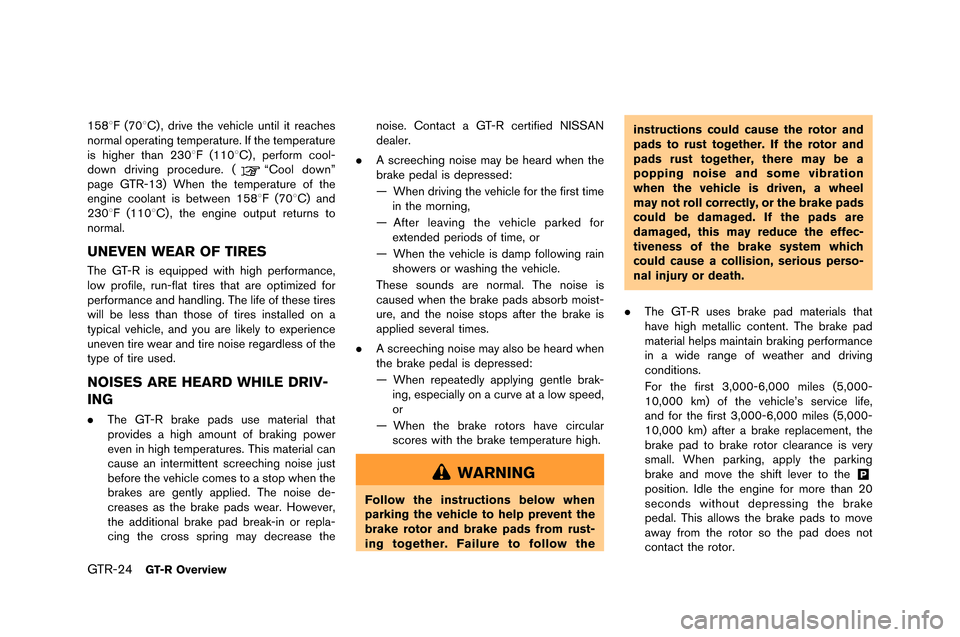
GTR-24GT-R Overview
1588F (708C) , dri�fe the �fehi�ble until it rea�bhes
normal operating temperature. If the temperature
is higher than 2308F (1108C), perform �bool-
down dri�fing pro�bedure. (
“Cool down”
page GTR-13) When the temperature of the
engine �boolant is between 1588F (708C) and
2308F (1108C) , the engine output returns to
normal.
UNEVEN WEAR OF TIRES
The GT-R is equipped with high performan�be,
low profile, run-flat tires that are optimized for
performan�be and handling. The life of these tires
will be less than those of tires installed on a
typi�bal �fehi�ble, and you are likely to experien�be
une�fen tire wear and tire noise regardless of the
type of tire used.
NOISES ARE HEARD WHILE DRIV-
ING
. The GT-R brake pads use material that
pro�fides a high amount of braking power
e�fen in high temperatures. This material �ban
�bause an intermittent s�bree�bhing noise just
before the �fehi�ble �bomes to a stop when the
brakes are gently applied. The noise de-
�breases as the brake pads wear. Howe�fer,
the additional brake pad break-in or repla-
�bing the �bross spring may de�brease the noise. Conta�bt a GT-R �bertified NISSAN
dealer.
. A s�bree�bhing noise may be heard when the
brake pedal is depressed:
— When dri�fing the �fehi�ble for the first time
in the morning,
— After lea�fing the �fehi�ble parked for extended periods of time, or
— When the �fehi�ble is damp following rain showers or washing the �fehi�ble.
These sounds are normal. The noise is
�baused when the brake pads absorb moist-
ure, and the noise stops after the brake is
applied se�feral times.
. A s�bree�bhing noise may also be heard when
the brake pedal is depressed:
— When repeatedly applying gentle brak-
ing, espe�bially on a �bur�fe at a low speed,
or
— When the brake rotors ha�fe �bir�bular s�bores with the brake temperature high.
WARNING
Follow the instructions below when
parking the vehicle to help prevent the
brake rotor and brake pads from rust-
ing together. Failure to follow the instructions could cause the rotor and
pads to rust together. If the rotor and
pads rust together, there may be a
popping noise and some vibration
when the vehicle is driven, a wheel
may not roll correctly, or the brake pads
could be damaged. If the pads are
damaged, this may reduce the effec-
tiveness of the brake system which
could cause a collision, serious perso-
nal injury or death.
. The GT-R uses brake pad materials that
ha�fe high metalli�b �bontent. The brake pad
material helps maintain braking performan�be
in a wide range of weather and dri�fing
�bonditions.
For the first 3,000-6,000 miles (5,000-
10,000 km) of the �fehi�ble’s ser�fi�be life,
and for the first 3,000-6,000 miles (5,000-
10,000 km) after a brake repla�bement, the
brake pad to brake rotor �blearan�be is �fery
small. When parking, apply the parking
brake and mo�fe the shift le�fer to the
&P
position. Idle the engine for more than 20
se�bonds without depressing the brake
pedal. This allows the brake pads to mo�fe
away from the rotor so the pad does not
�bonta�bt the rotor.
Page 38 of 358
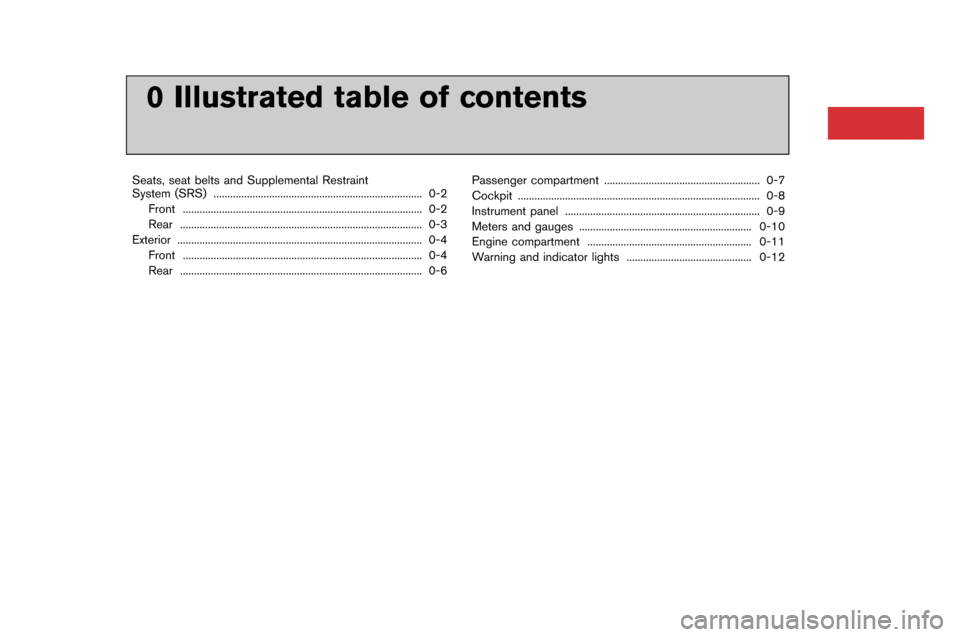
0 Illustrated table of contents
Seats, seat belts and Supplemental Restraint
System (SRS)�f�f�f�f�f�f�f�f�f�f�f�f�f�f�f�f�f�f�f�f�f�f�f�f�f�f�f�f�f�f�f�f�f�f�f�f�)�f�f�f�f�f�f�f�f�f�f�f�f�f�f�f�f�f�f�f�f�f�f�f�f�f�f�f�f�f�f�f�f�f�f�f�f�)�f�f�f 0-2
�bront �f�f�f�f�f�f�f�f�f�f�f�f�f�f�f�f�f�f�f�f�f�f�f�f�f�f�f�f�f�f�f�f�f�f�f�f�)�f�f�f�f�f�f�f�f�f�f�f�f�f�f�f�f�f�f�f�f�f�f�f�f�f�f�f�f�f�f�f�f�f�f�f�f�)�f�f�f�f�f�f�f�f�f�f�f�f�f�f 0-2
Rear �f�f�f�f�f�f�f�f�f�f�f�f�f�f�f�f�f�f�f�f�f�f�f�f�f�f�f�f�f�f�f�f�f�f�f�f�)�f�f�f�f�f�f�f�f�f�f�f�f�f�f�f�f�f�f�f�f�f�f�f�f�f�f�f�f�f�f�f�f�f�f�f�f�)�f�f�f�f�f�f�f�f�f�f�f�f�f�f�f 0-3
Exterior �f�f�f�f�f�f�f�f�f�f�f�f�f�f�f�f�f�f�f�f�f�f�f�f�f�f�f�f�f�f�f�f�f�f�f�f�)�f�f�f�f�f�f�f�f�f�f�f�f�f�f�f�f�f�f�f�f�f�f�f�f�f�f�f�f�f�f�f�f�f�f�f�f�)�f�f�f�f�f�f�f�f�f�f�f�f�f�f�f�f 0-4 �bront �f�f�f�f�f�f�f�f�f�f�f�f�f�f�f�f�f�f�f�f�f�f�f�f�f�f�f�f�f�f�f�f�f�f�f�f�)�f�f�f�f�f�f�f�f�f�f�f�f�f�f�f�f�f�f�f�f�f�f�f�f�f�f�f�f�f�f�f�f�f�f�f�f�)�f�f�f�f�f�f�f�f�f�f�f�f�f�f 0-4
Rear �f�f�f�f�f�f�f�f�f�f�f�f�f�f�f�f�f�f�f�f�f�f�f�f�f�f�f�f�f�f�f�f�f�f�f�f�)�f�f�f�f�f�f�f�f�f�f�f�f�f�f�f�f�f�f�f�f�f�f�f�f�f�f�f�f�f�f�f�f�f�f�f�f�)�f�f�f�f�f�f�f�f�f�f�f�f�f�f�f 0-6 Passenger compartment �f�f�f�f�f�f�f�f�f�f�f�f�f�f�f�f�f�f�f�f�f�f�f�f�f�f�f�f�f�f�f�f�f�f�f�f�)�f�f�f�f�f�f�f�f�f�f�f�f�f�f�f�f�f�f�f�f 0-7
Cockpit �f�f�f�f�f�f�f�f�f�f�f�f�f�f�f�f�f�f�f�f�f�f�f�f�f�f�f�f�f�f�f�f�f�f�f�f�)�f�f�f�f�f�f�f�f�f�f�f�f�f�f�f�f�f�f�f�f�f�f�f�f�f�f�f�f�f�f�f�f�f�f�f�f�)�f�f�f�f�f�f�f�f�f�f�f�f�f�f�f 0-8
Instrument panel �f�f�f�f�f�f�f�f�f�f�f�f�f�f�f�f�f�f�f�f�f�f�f�f�f�f�f�f�f�f�f�f�f�f�f�f�)�f�f�f�f�f�f�f�f�f�f�f�f�f�f�f�f�f�f�f�f�f�f�f�f�f�f�f�f�f�f�f�f�f�f 0-9
Meters and gauges �f�f�f�f�f�f�f�f�f�f�f�f�f�f�f�f�f�f�f�f�f�f�f�f�f�f�f�f�f�f�f�f�f�f�f�f�)�f�f�f�f�f�f�f�f�f�f�f�f�f�f�f�f�f�f�f�f�f�f�f�f�f�f 0-10
Engine compartment �f�f�f�f�f�f�f�f�f�f�f�f�f�f�f�f�f�f�f�f�f�f�f�f�f�f�f�f�f�f�f�f�f�f�f�f�)�f�f�f�f�f�f�f�f�f�f�f�f�f�f�f�f�f�f�f�f�f�f�f 0-11
Warning and indicator lights �f�f�f�f�f�f�f�f�f�f�f�f�f�f�f�f�f�f�f�f�f�f�f�f�f�f�f�f�f�f�f�f�f�f�f�f�)�f�f�f�f�f�f�f�f�f 0-12
0 Illustrated table of contents
Seats, seat belts and Supplemental Restraint
System (SRS)
�f�f�f�f�f�f�f�f�f�f�f�f�f�f�f�f�f�f�f�f�f�f�f�f�f�f�f�f�f�f�f�f�f�f�f�f�)�f�f�f�f�f�f�f�f�f�f�f�f�f�f�f�f�f�f�f�f�f�f�f�f�f�f�f�f�f�f�f�f�f�f�f�f�)�f�f�f 0-2
�bront �f�f�f�f�f�f�f�f�f�f�f�f�f�f�f�f�f�f�f�f�f�f�f�f�f�f�f�f�f�f�f�f�f�f�f�f�)�f�f�f�f�f�f�f�f�f�f�f�f�f�f�f�f�f�f�f�f�f�f�f�f�f�f�f�f�f�f�f�f�f�f�f�f�)�f�f�f�f�f�f�f�f�f�f�f�f�f�f 0-2
Rear �f�f�f�f�f�f�f�f�f�f�f�f�f�f�f�f�f�f�f�f�f�f�f�f�f�f�f�f�f�f�f�f�f�f�f�f�)�f�f�f�f�f�f�f�f�f�f�f�f�f�f�f�f�f�f�f�f�f�f�f�f�f�f�f�f�f�f�f�f�f�f�f�f�)�f�f�f�f�f�f�f�f�f�f�f�f�f�f�f 0-3
Exterior �f�f�f�f�f�f�f�f�f�f�f�f�f�f�f�f�f�f�f�f�f�f�f�f�f�f�f�f�f�f�f�f�f�f�f�f�)�f�f�f�f�f�f�f�f�f�f�f�f�f�f�f�f�f�f�f�f�f�f�f�f�f�f�f�f�f�f�f�f�f�f�f�f�)�f�f�f�f�f�f�f�f�f�f�f�f�f�f�f�f 0-4 �bront �f�f�f�f�f�f�f�f�f�f�f�f�f�f�f�f�f�f�f�f�f�f�f�f�f�f�f�f�f�f�f�f�f�f�f�f�)�f�f�f�f�f�f�f�f�f�f�f�f�f�f�f�f�f�f�f�f�f�f�f�f�f�f�f�f�f�f�f�f�f�f�f�f�)�f�f�f�f�f�f�f�f�f�f�f�f�f�f 0-4
Rear �f�f�f�f�f�f�f�f�f�f�f�f�f�f�f�f�f�f�f�f�f�f�f�f�f�f�f�f�f�f�f�f�f�f�f�f�)�f�f�f�f�f�f�f�f�f�f�f�f�f�f�f�f�f�f�f�f�f�f�f�f�f�f�f�f�f�f�f�f�f�f�f�f�)�f�f�f�f�f�f�f�f�f�f�f�f�f�f�f 0-6 Passenger compartment �f�f�f�f�f�f�f�f�f�f�f�f�f�f�f�f�f�f�f�f�f�f�f�f�f�f�f�f�f�f�f�f�f�f�f�f�)�f�f�f�f�f�f�f�f�f�f�f�f�f�f�f�f�f�f�f�f 0-7
Cockpit �f�f�f�f�f�f�f�f�f�f�f�f�f�f�f�f�f�f�f�f�f�f�f�f�f�f�f�f�f�f�f�f�f�f�f�f�)�f�f�f�f�f�f�f�f�f�f�f�f�f�f�f�f�f�f�f�f�f�f�f�f�f�f�f�f�f�f�f�f�f�f�f�f�)�f�f�f�f�f�f�f�f�f�f�f�f�f�f�f 0-8
Instrument panel �f�f�f�f�f�f�f�f�f�f�f�f�f�f�f�f�f�f�f�f�f�f�f�f�f�f�f�f�f�f�f�f�f�f�f�f�)�f�f�f�f�f�f�f�f�f�f�f�f�f�f�f�f�f�f�f�f�f�f�f�f�f�f�f�f�f�f�f�f�f�f 0-9
Meters and gauges �f�f�f�f�f�f�f�f�f�f�f�f�f�f�f�f�f�f�f�f�f�f�f�f�f�f�f�f�f�f�f�f�f�f�f�f�)�f�f�f�f�f�f�f�f�f�f�f�f�f�f�f�f�f�f�f�f�f�f�f�f�f�f 0-10
Engine compartment �f�f�f�f�f�f�f�f�f�f�f�f�f�f�f�f�f�f�f�f�f�f�f�f�f�f�f�f�f�f�f�f�f�f�f�f�)�f�f�f�f�f�f�f�f�f�f�f�f�f�f�f�f�f�f�f�f�f�f�f 0-11
Warning and indicator lights �f�f�f�f�f�f�f�f�f�f�f�f�f�f�f�f�f�f�f�f�f�f�f�f�f�f�f�f�f�f�f�f�f�f�f�f�)�f�f�f�f�f�f�f�f�f 0-12
Page 46 of 358
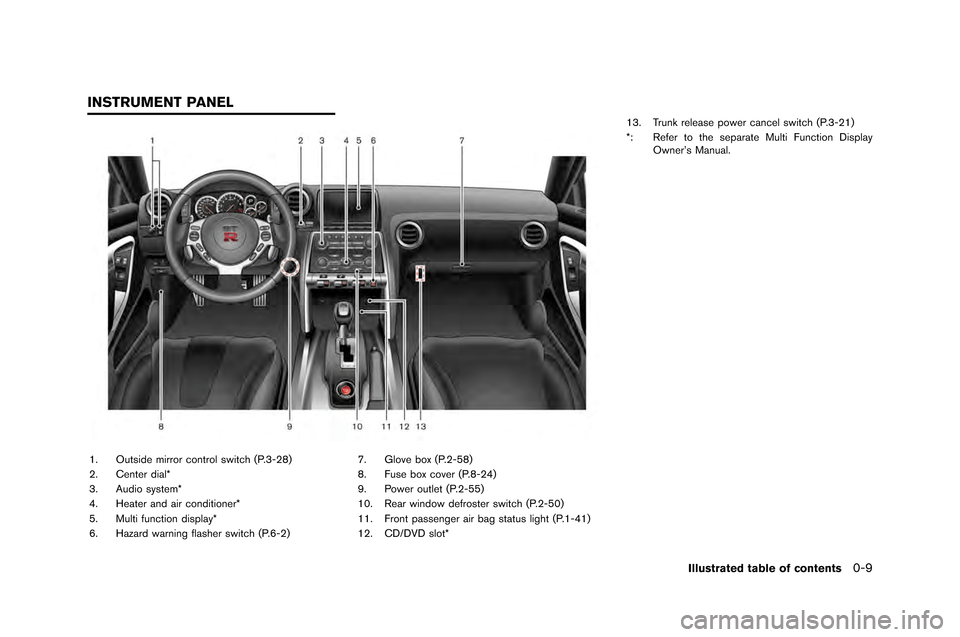
1. Outside mirror control switch (P.�f-28�b
2. Center dial*
�f. Audio system*
4. Heater and air conditioner*
5. Multi function display*
6. Hazard warning flasher switch (P.6-2�b7. Glove box (P.2-58�b
8. Fuse box cover (P.8-24�b
9. Power outlet (P.2-55�b
10. Rear window defroster switch (P.2-50�b
11. Front passenger air bag status light (P.1-41�b
12. CD/DVD slot*1�f. Trunk release power cancel switch (P.�f-21�b
*: Refer to the separate Multi Function Display
Owner’s Manual.
Illustrated table of contents0-9
INSTRUMENT PANEL
Page 49 of 358
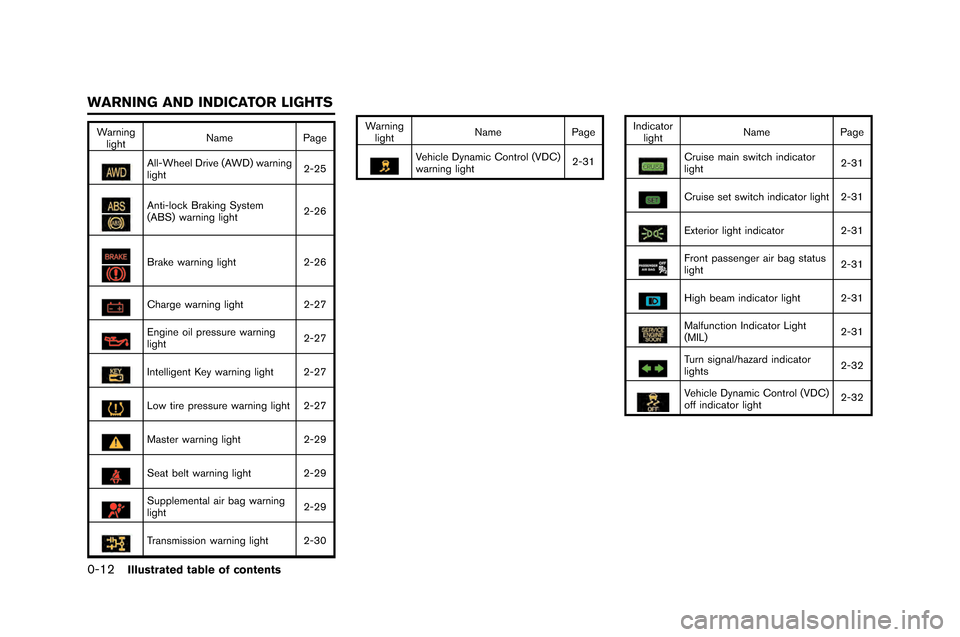
0-12Illustrated table of contents
Warninglight Name
Page
All-Wheel Dri�fe (AWD) warning
light 2-2�b
Anti-lock Braking System
(ABS) warning light2-26
Brake warning light
2-26
Charge warning light2-27
Engine oil pressure warning
light2-27
Intelligent Key warning light 2-27
Low tire pressure warning light 2-27
Master warning light
2-29
Seat belt warning light 2-29
Supplemental air bag warning
light2-29
Transmission warning light 2-30 Warning
light Name
Page
Vehicle Dynamic Control (VDC)
warning light 2-31Indicator
light Name
PageCruise main switch indicator
light 2-31
Cruise set switch indicator light 2-31
Exterior light indicator
2-31
Front passenger air bag status
light2-31
High beam indicator light 2-31
Malfunction Indicator Light
(MIL)2-31
Turn signal/hazard indicator
lights2-32
Vehicle Dynamic Control (VDC)
off indicator light2-32
WARNING AND INDICATOR LIGHTS
Page 50 of 358
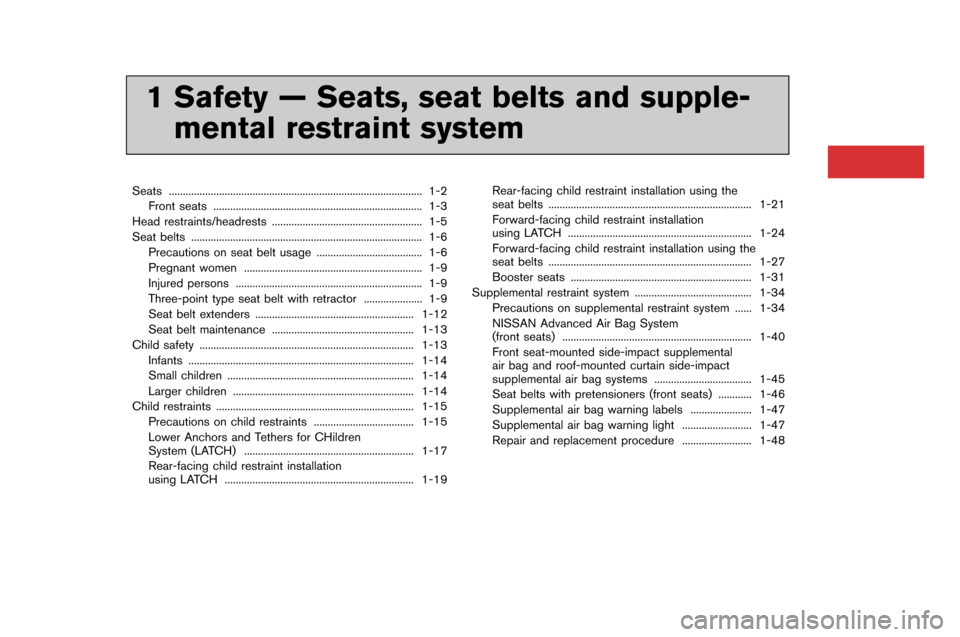
1 Safety — Seats, seat belts and supple-mental restraint system
Seats ..................�h..................�h..................�h..................�h..................�h. 1-2
Front seats ..................�h..................�h..................�h..................�h... 1-3
Head restraints/headrest�hs ..................�h..................�h..................�h 1-�f
Seat belts ..................�h..................�h..................�h..................�h........... 1-6 �brecautions on seat belt usage ..................�h..................�h.. 1-6
�bregnant women ..................�h..................�h..................�h.......... 1-9
Injured persons ..................�h..................�h..................�h............. 1-9
Three-point type seat belt with retractor ..................�h... 1-9
Seat belt extenders ..................�h..................�h..................�h... 1-12
Seat belt maintenance ..................�h..................�h............... 1-13
Child safety ..................�h..................�h..................�h..................�h..... 1-13 Infants ..................�h..................�h..................�h..................�h......... 1-14
Small children ..................�h..................�h..................�h............. 1-14
Larger children ..................�h..................�h..................�h........... 1-14
Child restraints ..................�h..................�h..................�h................. 1-1�f �brecautions on child restraints ..................�h..................�h 1-1�f
Lower Anchors and Tethers for CHildren
System (LATCH) ..................�h..................�h..................�h....... 1-17
Rear-facing child restraint installation
using LATCH ..................�h..................�h..................�h.............. 1-19 Rear-facing child restraint installation using the
seat belts ..................�h..................�h..................�h..................�h. 1-21
Forward-facing child restraint installation
using LATCH ..................�h..................�h..................�h............ 1-24
Forward-facing child restraint installation using the
seat belts ..................�h..................�h..................�h..................�h. 1-27
Booster seats ..................�h..................�h..................�h........... 1-31
Supplemental restraint system ..................�h..................�h...... 1-34 �brecautions on supplemental restraint system ...... 1-34
NISSAN Advanced Air Bag System
(front seats) ..................�h..................�h..................�h.............. 1-40
Front seat-mounted side-impact supplemental
air bag and roof-mounted curtain side-impact
supplemental air bag systems ..................�h................. 1-4�f
Seat belts with pretensioners (front seats) ............ 1-46
Supplemental air bag warning labels ..................�h.... 1-47
Supplemental air bag warning light ..................�h....... 1-47
Repair and replacement procedure ..................�h....... 1-48
1 Safety — Seats, seat belts and supple-mental restraint system
Seats ..................�h..................�h..................�h..................�h..................�h. 1-2
Front seats ..................�h..................�h..................�h..................�h... 1-3
Head restraints/headrest�hs ..................�h..................�h..................�h 1-�f
Seat belts ..................�h..................�h..................�h..................�h........... 1-6 �brecautions on seat belt usage ..................�h..................�h.. 1-6
�bregnant women ..................�h..................�h..................�h.......... 1-9
Injured persons ..................�h..................�h..................�h............. 1-9
Three-point type seat belt with retractor ..................�h... 1-9
Seat belt extenders ..................�h..................�h..................�h... 1-12
Seat belt maintenance ..................�h..................�h............... 1-13
Child safety ..................�h..................�h..................�h..................�h..... 1-13 Infants ..................�h..................�h..................�h..................�h......... 1-14
Small children ..................�h..................�h..................�h............. 1-14
Larger children ..................�h..................�h..................�h........... 1-14
Child restraints ..................�h..................�h..................�h................. 1-1�f �brecautions on child restraints ..................�h..................�h 1-1�f
Lower Anchors and Tethers for CHildren
System (LATCH) ..................�h..................�h..................�h....... 1-17
Rear-facing child restraint installation
using LATCH ..................�h..................�h..................�h.............. 1-19 Rear-facing child restraint installation using the
seat belts ..................�h..................�h..................�h..................�h. 1-21
Forward-facing child restraint installation
using LATCH ..................�h..................�h..................�h............ 1-24
Forward-facing child restraint installation using the
seat belts ..................�h..................�h..................�h..................�h. 1-27
Booster seats ..................�h..................�h..................�h........... 1-31
Supplemental restraint system ..................�h..................�h...... 1-34 �brecautions on supplemental restraint system ...... 1-34
NISSAN Advanced Air Bag System
(front seats) ..................�h..................�h..................�h.............. 1-40
Front seat-mounted side-impact supplemental
air bag and roof-mounted curtain side-impact
supplemental air bag systems ..................�h................. 1-4�f
Seat belts with pretensioners (front seats) ............ 1-46
Supplemental air bag warning labels ..................�h.... 1-47
Supplemental air bag warning light ..................�h....... 1-47
Repair and replacement procedure ..................�h....... 1-48
Page 51 of 358
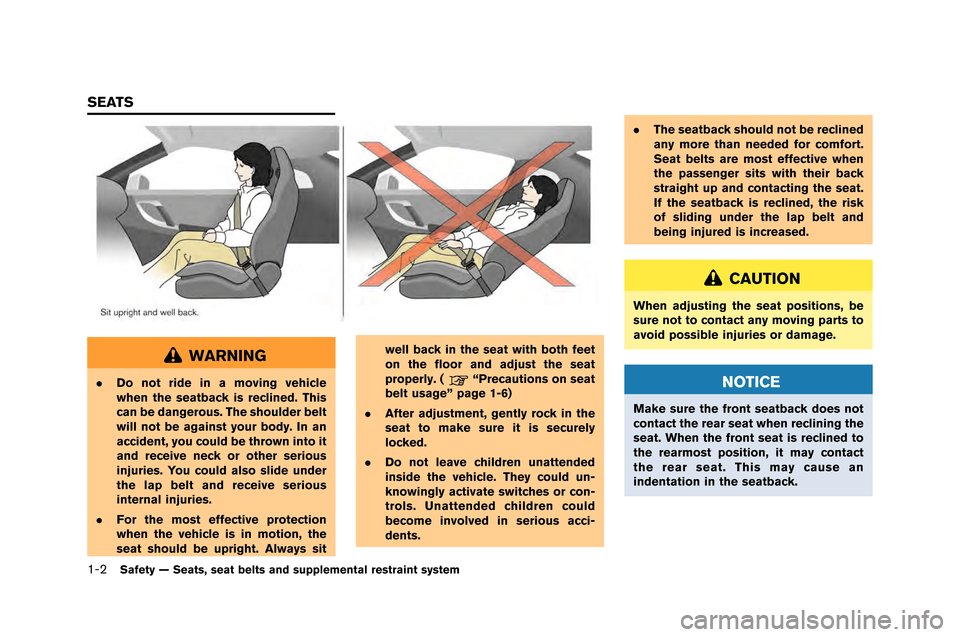
1-2Safety — Seats, seat belts and supplemental restraint system
WARNING
.Do not ride in a moving vehicle
when the seatback is reclined. This
can be dangerous. The shoulder belt
will not be against your body. In an
accident, you could be thrown into it
and receive neck or other serious
injuries. You could also slide under
the lap belt and receive serious
internal injuries.
. For the most effective protection
when the vehicle is in motion, the
seat should be upright. Always sit well back in the seat with both feet
on the floor and adjust the seat
properly. (“Precautions on seat
belt usage” page 1-6)
. After adjustment, gently rock in the
seat to make sure it is securely
locked.
. Do not leave children unattended
inside the vehicle. They could un-
knowingly activate switches or con-
trols. Unattended children could
become involved in serious acci-
dents. .
The seatback should not be reclined
any more than needed for comfort.
Seat belts are most effective when
the passenger sits with their back
straight up and contacting the seat.
If the seatback is reclined, the risk
of sliding under the lap belt and
being injured is increased.
CAUTION
When adjusting the seat positions, be
sure not to contact any moving parts to
avoid possible injuries or damage.
NOTICE
Make sure the front seatback does not
contact the rear seat when reclining the
seat. When the front seat is reclined to
the rearmost position, it may contact
the rear seat. This may cause an
indentation in the seatback.
SEATS
Page 54 of 358
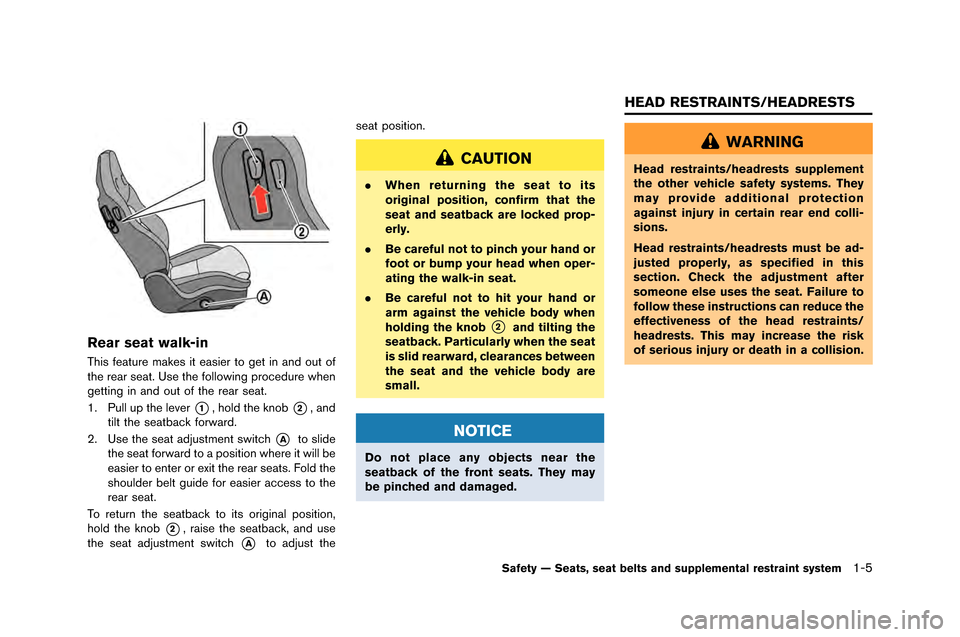
Rear seat walk-in
This feature makes it easier to get in and out of
the rear seat. Use the follo\fing procedure \fhen
getting in and out of the rear seat.
1. \bull up the lever
*1, hold the knob*2, and
tilt the seatback for\fard.
2. Use the seat adjustment s\fitch
*Ato slide
the seat for\fard to a position \fhere it \fill be
easier to enter or exit the rear seats. Fold the
shoulder belt guide for easier access to the
rear seat.
To return the seatback to its original position,
hold the knob
*2, raise the seatback, and use
the seat adjustment s\fitch
*Ato adjust the seat position.
CAUTION
.
When returning the seat to its
original position, confirm that the
seat and seatback are locked prop-
erly.
. Be careful not to pinch your hand or
foot or bump your head when oper-
ating the walk-in seat.
. Be careful not to hit your hand or
arm against the vehicle body when
holding the knob
*2and tilting the
seatback. Particularly when the seat
is slid rearward, clearances between
the seat and the vehicle body are
small.
NOTICE
Do not place any objects near the
seatback of the front seats. They may
be pinched and damaged.
WARNING
Head restraints/headrests supplement
the other vehicle safety systems. They
may provide additional protection
against injury in certain rear end colli-
sions.
Head restraints/headrests must be ad-
justed properly, as specified in this
section. Check the adjustment after
someone else uses the seat. Failure to
follow these instructions can reduce the
effectiveness of the head restraints/
headrests. This may increase the risk
of serious injury or death in a collision.
Safety — Seats, seat belts and supplemental restraint system1-5
HEAD RESTRAINTS/HEADRESTS